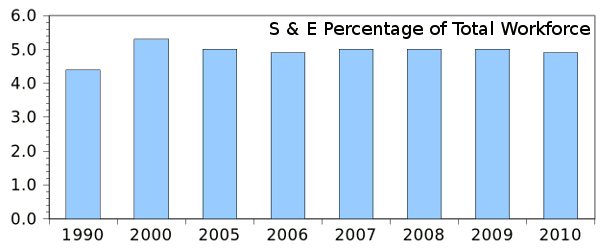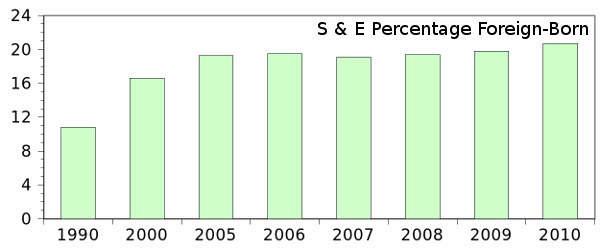Stalled Science
March 9, 2012
Companies are rightfully concerned about their
growth rate, typically measured by
net income, although other
correlating measures can be used. When such beneficent things increase quarter-to-quarter, or year-to-year, you know that your company is doing well. Stagnant sales from one time period to the next could be the
harbinger of declining sales in the future. Soon, you might be out of business.
A recent report by the
Population Reference Bureau on the
science and
engineering workforce in the US has confirmed an alarming trend. This workforce was 5.3% of total workers in 2000; it's stayed essentially the same in the years since; and it's declined to 4.9% in 2010.[1-2]
US President, Barack Obama, stated last year that the US needs to train an additional 10,000 engineers annually.[3]

US science and engineering employment, years 1990-2010, as a percentage of the total workforce.[1] (Rendered by author using Gnumeric.)

Foreign-born percentage of the US science and engineering workforce, years 1990-2010.[1] (Rendered by author using Gnumeric.)
Why don't
children pursue science and engineering jobs? Children are smarter than we think. Present two piles of treats to a young child, one pile twice as large as the other. To access the smaller pile, he needs to solve a
maze. To access the larger pile, he just needs to reach out and stuff his pockets full. Not only that, but he's told that if he chooses the larger pile, it will be there for him the next day, but the smaller pile will likely be moved to some neighbor's house. So, which pile would he choose?

As a child, I consumed mass quantities of Red Dye No. 2, before it was banned by the FDA in 1976.
(Photograph by Evan-Amos, via Wikimedia Commons.)
Science and technology jobs in the US are just like that. People at the
management and
finance side of large companies make the big bucks, and the technical people get their benefits cut and their jobs
outsourced. This trend has been apparent for the past decade, and the decline in science and technology enrollments are not an unexpected outcome.
As
advertisers know, you can get people to buy anything with the right approach, so the government is launching another program to promote science and engineering education. What's more important is that it's attempting to offset one of the root causes of its science talent problem, the
offshoring of science and technology jobs by US companies, by creating some science and engineering jobs in the US.
The proposed Fiscal Year 2013 Budget includes increases in money for
STEM (science, technology, engineering, and
mathematics) education, but also some increased federal government
research and development spending. $3.0 billion in funding has been proposed for STEM education, with a call for improvements in
teaching.
Although
high school science
teachers usually possess science degrees, administrators still haven't discovered that
elementary school science should also be taught by scientists. Instead, there are too many roadblocks set in place to discourage science professionals from entering teaching.
There's a proposed 4.4% increase in the budgets of the
National Science Foundation, the
Department of Energy's Office of Science, and the
National Institute of Standards and Technology laboratories, thereby bringing the funding of these up to $13.1 billion. Much of this funding is directed to
renewable energy research and development.
America also needs a
renaissance in
manufacturing. So much has been offshored for so long that manufacturing capability has been lost in many high technology areas. The budget calls for an advanced manufacturing initiative that includes innovative manufacturing processes, advanced industrial materials, and
robotics. There's also a call for greater collaboration between federal agencies and industry.
The education initiative won't show any results for a long time; and, it won't show any results at all unless STEM graduates have a much nicer and more stable work environment - Somewhat like what my colleagues and I had several decades ago in industrial research.
References:
- Mark Mather and Diana Lavery, "U.S. Science and Engineering Labor Force Stalls, but Trends Vary Across States," Population Reference Bureau Report, February 2012.
- Patrick Thibodeau, "Science-and-engineering workforce has stalled in U.S., report says - Could that mean less innovation?" Computer World, March 2, 2012.
- Patrick Thibodeau, "Obama: 'We don't have enough engineers'," Computer World, June 14, 2011.
- Innovation for America's Economy, America's Energy, and American Skills: The FY 2013 Science and Technology R&D Budget, White House Press Release, February 13, 2012
Permanent Link to this article
Linked Keywords: Company; growth rate; net income; correlation; harbinger; Population Reference Bureau; science; engineering; US President, Barack Obama; Gnumeric; children; maze; Coneheads; mass quantities; Red Dye No. 2; Food and Drug Administration; FDA; Evan-Amos; Wikimedia Commons; management; finance; outsourcing; outsource; advertising; advertiser; offshoring; STEM; mathematics; research and development; teaching; high school; teacher; elementary school; National Science Foundation; Department of Energy; Office of Science; National Institute of Standards and Technology; renewable energy; renaissance; manufacturing; robotics.